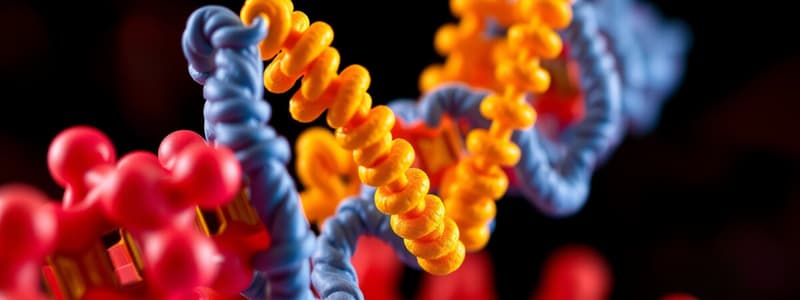Podcast
Questions and Answers
What is the primary role of Complex I in the electron transport chain?
What is the primary role of Complex I in the electron transport chain?
- To facilitate the oxidation of ubiquinone into NADH
- To transfer electrons from NADH to ubiquinone (correct)
- To pump protons into the mitochondrial matrix
- To convert NADH to ATP directly
Which component of Complex I accepts the first electron from NADH?
Which component of Complex I accepts the first electron from NADH?
- Flavin Mono-nucleotide (FMN) (correct)
- Ubiquinone
- Iron-sulfur clusters
- Cytochrome c
How do Fe-S clusters contribute to the electron transport chain?
How do Fe-S clusters contribute to the electron transport chain?
- They act solely as storage for electrons.
- They directly produce ATP by coupling to ATP synthase.
- They facilitate the binding of coenzyme Q.
- They shuttle electrons with varying redox potential. (correct)
What function does ubiquinone serve in Complex I?
What function does ubiquinone serve in Complex I?
What is the main function of ATP synthase in the context of the proton motive force (PMF)?
What is the main function of ATP synthase in the context of the proton motive force (PMF)?
What role does the proton motive force (PMF) play in ATP synthesis?
What role does the proton motive force (PMF) play in ATP synthesis?
Which component of ATP synthase is responsible for proton movement?
Which component of ATP synthase is responsible for proton movement?
How does cytochrome c contribute to cellular respiration?
How does cytochrome c contribute to cellular respiration?
What is the primary function of cardiolipin in context of ATP synthase?
What is the primary function of cardiolipin in context of ATP synthase?
What happens to the binding sites in the F1 domain of ATP synthase during rotation of the g stalk?
What happens to the binding sites in the F1 domain of ATP synthase during rotation of the g stalk?
What is the primary role of cardiolipin in the inner mitochondrial membrane?
What is the primary role of cardiolipin in the inner mitochondrial membrane?
How many electrons does Complex IV transfer to molecular oxygen to reduce it to water?
How many electrons does Complex IV transfer to molecular oxygen to reduce it to water?
What effect does cyanide have on Complex IV?
What effect does cyanide have on Complex IV?
What components are involved in Complex IV's electron transfer mechanism?
What components are involved in Complex IV's electron transfer mechanism?
What is the main function of ATP synthase in the mitochondria?
What is the main function of ATP synthase in the mitochondria?
Which of the following statements is true regarding cardiolipin's role?
Which of the following statements is true regarding cardiolipin's role?
Which of the following complexes is the last proton pumping complex in the electron transport chain?
Which of the following complexes is the last proton pumping complex in the electron transport chain?
What structural characteristic is notable about ATP synthase?
What structural characteristic is notable about ATP synthase?
Study Notes
ATP Synthase and Proton Motive Force (PMF)
- ATP Synthase, also known as F1F0 ATPase, utilizes proton motive force (PMF) to generate ATP.
- The electron transport chain (ETC) begins with Complex I, also referred to as NADH:ubiquinone oxidoreductase.
- Complex I consists of 46 protein subunits and facilitates the conversion of high-energy NADH from the TCA cycle and fatty acid catabolism into PMF.
Complex I Mechanism
- NADH binds to flavin mononucleotide (FMN), the first electron acceptor, forming reduced flavin (FMNH2).
- FMN functionalities are similar to FAD, transferring electrons sequentially to iron-sulfur (Fe-S) clusters.
- Various Fe-S clusters in Complex I assist in electron transfer, each with unique redox potentials due to differing orientations and environments.
Ubiquinone in Complex I
- Ubiquinone (Coenzyme Q) binding occurs in a pocket within Complex I, facilitating further electron transfer in the ETC.
- PMF enables conformational changes in proteins to enhance ATP synthesis.
- ATP synthesis mechanism comprises the F0 pore and F1 nucleotide binding domains, with a rotational speed of approximately 6,000 RPM.
- Three protons traversing the F0 channel yield enough energy for the synthesis of one ATP molecule.
Structure and Function of ATP Synthase F0 and F1
- F0 consists of 10 c subunits in a ring, rotating driven by the proton gradient.
- Protons move between the interfaces of the c subunit ring and specific subunits of F1.
- F1's binding sites consist of one alpha and one beta subunit, surrounding a central gamma stalk.
- Rotation of the gamma stalk influences the conformation and function of the alpha and beta subunits, cycling through ATP bound, ADP + Pi bound, and ATP release states.
Oxidative Phosphorylation Process
- Electrons derived from catabolism progress through the ETC, generating a proton motive force by expelling protons into the intermembrane space.
- These electrons ultimately reduce molecular oxygen, forming water (H2O) while PMF is harnessed for ATP generation.
Cardiolipin's Role in Mitochondria
- Cardiolipin in the inner mitochondrial membrane forms a supramolecular assembly linking Complex III and Complex IV with cytochrome c.
- Acts as a proton trap, helping localize protons near electron transfer complexes and ATP synthase, influencing ATP synthesis and mitochondrial function.
- Also implicated in apoptosis and response to reactive oxygen species (ROS).
Complex IV - Cytochrome c Oxidase
- Complex IV is the final proton-pumping component of the electron transport chain, catalyzing electron transfer from reduced cytochrome c to molecular oxygen.
- Comprised of 13 polypeptide chains, 2 heme groups, and 3 copper ions.
- Notable centers include CuA/CuA and CuB; transfers 4 electrons to O2, yielding 2 water molecules (H2O).
Mechanism of Electron Transfer in Complex IV
- CuA/CuA accepts electrons from cytochrome c; one electron moves to CuB, the other to heme a3.
- Oxygen binds between CuB and heme a3, with protons added from the matrix enhancing the proton gradient.
- Energy released in this process helps pump additional protons across the membrane, completing two cycles for each O2 molecule utilized.
Inhibition and Challenges of Complex IV
- Complex IV activity is inhibited by cyanide (CN-), carbon monoxide, azide, and hydrogen sulfide, which bind at the oxygen-binding site.
- Release of reactive oxygen species (ROS) presents potential issues in mitochondrial function and maintains the potential for oxidative stress.
Summary of Electron Transport Chain and ATP Synthase
- The final stage of the ETC culminates in ATP Synthase, also referred to as F1F0 ATPase or Complex V, an intricate enzyme complex comprising 17 proteins.
Studying That Suits You
Use AI to generate personalized quizzes and flashcards to suit your learning preferences.
Related Documents
Description
This quiz covers the mechanisms of ATP synthase and Complex I of the electron transport chain. It will test your understanding of proton motive force (PMF) and the roles of NADH, FMN, and ubiquinone in energy production processes. Sharpen your knowledge of cellular respiration and these critical biochemical pathways.




